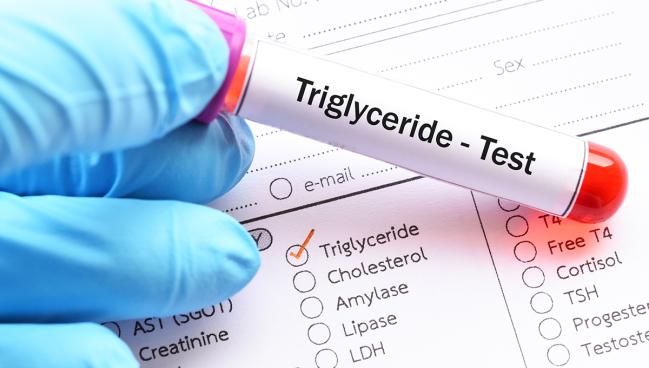Two siRNA Therapeutics Safely Lower Triglycerides in Mixed Hyperlipidemia
The siRNA agents work on different genetic targets, and both have an impact on apoB and remnant cholesterol levels.

Two new small interfering RNA (siRNA) therapeutics (both Arrowhead Pharmaceuticals), each targeting different genes involved in the regulation of triglyceride-rich lipoproteins, have been shown to be safe and effective for patients with mixed hyperlipidemia.
Zodasiran, which disrupts the expression of ANGPTL3, significantly slashed triglyceride levels and reduced non-HDL cholesterol and apolipoprotein B (apoB) levels at 24 weeks in the ARCHES-2 study of patients with mixed hyperlipidemia. In the MUIR study, plozasiran, an siRNA therapeutic that reduces the expression of APOC3, also significantly cut triglyceride levels, as well as apoB levels, across a range of doses and dosing schedules.
The two phase IIb studies, which were presented at the European Atherosclerosis Society meeting in Lyon, France, and published simultaneously in the New England Journal of Medicine, justify larger-scale cardiovascular outcomes trials, according to investigators.
“It’s really exciting,” Christie Ballantyne, MD (Baylor College of Medicine, Houston, TX), lead investigator of the MUIR study, told TCTMD. “The data look very promising,” he added. “Big reductions in triglycerides. The sweet spot is probably the 25-mg dose.”
Robert Rosenson, MD (Icahn School of Medicine at Mount Sinai, New York, NY), who led ARCHES-2 with zodasiran, said there are limited treatments for patients with mixed hyperlipidemia at present.
“First-line therapy is statins, which can lower triglycerides from about 22% to maybe 40% with high doses of atorvastatin,” he told TCTMD. “Non-statin therapies have been evaluated to lower triglycerides. However, those studies with fibrates and the fish oil capsules for triglyceride-lowering have consistently failed to reduce cardiovascular events. Nonetheless, fibrates remain the second most prescribed class of lipid-lowering therapy worldwide.”
Brian Bergmark, MD (Brigham and Women’s Hospital, Boston, MA), who wasn’t involved in these studies but has led different trials with antisense oligonucleotides (ASO) targeting APOC3 and ANGPTL3, said the findings hint at expanded personalized medicine targets for patients with dysfunctional lipid metabolism.
“We’re close to having numerous ways of doing that and I think that is going to be really good for patients,” he told TCTMD.
Unlike patients with severe hyperlipidemia who need to lower triglycerides to reduce the risk of acute pancreatitis, that’s not the case for those with mixed hyperlipidemia, he said.
“But we are looking at this as a route to achieve other clinically meaningful outcomes, whether lowering their risk of myocardial infarction, stroke, peripheral artery disease, that sort of thing, and maybe also lowering their hepatic fat content. Here, the triglycerides aren’t really the focus so much as the other parameters.”
Bergmark said that one of the outstanding scientific questions is whether reducing triglyceride-rich lipoproteins with a drug that lowers apolipoprotein B will translate into a reduction in cardiovascular risk.
“That’s actually not known,” he said.
An accompanying editorial by Pradeep Natarajan, MD (Massachusetts General Hospital, Boston, MA), said these new studies highlight the importance of studying diverse populations to identify exceptional genetic variants, such as PCSK9, APOC3, and ANGPTL3.
MUIR and ARCHES-2
Both APOC3 and ANGPTL3 were found through genome-wide association studies in which researchers identified populations with loss-of-function variants who had low triglycerides and a lower incidence of cardiovascular disease. APOC3 is a key regulator in triglyceride-rich lipoprotein metabolism while ANGPTL3 regulates lipids and lipoproteins, including the metabolism of triglycerides, by inhibiting lipoprotein lipase, endothelial lipase, and the uptake of hepatic lipoproteins.
The 48-week MUIR study included 353 men and women (mean age 61 years) with mixed hyperlipidemia, which was defined as a triglyceride level of 150 to 499 mg/dL and either LDL cholesterol ³ 70 mg/dL or non-HDL cholesterol ³ 100 mg/dL. Patients were randomized to a subcutaneous injection of plozasiran 10 mg, 25 mg, or 50 mg or placebo on day 1 and at week 12 while another cohort received plozasiran 50 mg on day 1 and at 24 weeks.
At baseline, the mean triglyceride level was 244 mg/dL (2.75 mmol/L) and mean fasting LDL cholesterol was 103 mg/dL. More than 90% of patients in the five study arms were treated with statins, a little more than half receiving a high-intensity statin, and 14% were taking fibrates. Use of other agents, including icosapent ethyl (Vascepa; Amarin) and other omega-3 fatty acids, was infrequent. Roughly 60% of patients had diabetes.
Fasting triglyceride levels at week 24, the study’s primary endpoint, declined 49.8% with the 10-mg dose, 56.0% with the 25-mg dose, and 62.4% with the 50-mg dose. For those who received plozasiran every 24 weeks, fasting triglycerides compared with placebo declined 44.2%.
APOC3 levels also declined significantly, down as much as 78.5% with the 50-mg quarterly dose, and non-HDL cholesterol declined by 16.7% with the 10-mg dose to as much as 24.2% with 50-mg quarterly dose. There were also significant reductions in apoB and remnant cholesterol.
“The LDL cholesterol doesn’t change much—it went down a little at our top dose—but what's interesting is that the reduction in non-HDL cholesterol is being driven by a reduction in remnant cholesterol, not LDL cholesterol,” said Ballantyne.
There was no significant risk of serious adverse events with plozasiran compared with placebo, but investigators observed worsening glycemic control with the 50-mg dose.
Reductions in Remnant Cholesterol
With ARCHES-2, investigators randomized 204 men and women (mean age 61 years) with mixed hyperlipidemia to subcutaneous injections of zodasiran 50 mg, 100 mg, or 200 mg, or placebo on day 1 and at week 12. The mean triglyceride level was similar to that in the MUIR trial (mean 246 mg/dL) and the mean LDL cholesterol level was 97 mg/dL. Nearly all patients were treated with statins, with 37% receiving high-intensity statins, and 21% were also treated with fibrates.
At 24 weeks, zodasiran reduced triglyceride levels by 51%, 57%, and 63% with the 50-, 100-, and 200-mg doses, respectively, when compared against placebo. ANGPTL3 levels declined in parallel with triglyceride levels, while an exploratory analysis showed that remnant cholesterol levels also declined with treatment. Similarly, there were reductions in LDL cholesterol and apoB.
“The triglyceride levels were the primary endpoint, but in terms of atherosclerosis, the remnant cholesterol, which fell by as much as 82%, contains five times more cholesterol per particle than an LDL particle,” said Rosenson. “Thus far, we have not had any tools, in terms of pharmacological agents, to test the remnant cholesterol hypothesis. So, the fact that you're reducing the remnant cholesterol and lowering apolipoprotein B, the major protein on the atherogenic lipoproteins, by 22% is encouraging.”
There was no difference in adverse events between treatment and placebo, but urinary tract infections were more common in patients treated with zodasiran 200 mg. Rosenson said, however, that there were more patients with diabetes in the 200-mg group and the urinary tract infections were confined to people with established diabetes with the worst glycemic control.
“This would be anticipated from poorly controlled diabetes, but other than that the therapy was clean,” he said.
Liver Enzymes and Hepatotoxicity
The past several years have seen multiple agents fail to safely and successfully target triglycerides. In the large PROMINENT trial, treating patients with type 2 diabetes, mild-to-moderate hypertriglyceridemia, and low HDL cholesterol levels with pemafibrate (Parmodia; Kowa Pharmaceuticals) failed to reduce the risk of major cardiovascular events. In the study, pemafibrate lowered triglycerides, but increased LDL cholesterol and modestly increased apoB levels.
Vupanorsen, an ASO that targeted ANGPTL3, ran into problems in the TRANSLATE-TIMI 70 study led by Bergmark and colleagues when investigators found significant safety concerns, including hepatotoxicity, particularly at the higher doses. Pfizer, which licensed the drug from Ionis Pharmaceuticals, discontinued its development. Volanesorsen, another ASO, targeted APOC3 and reduced triglyceride levels in patients with familial chylomicronemia but never was approved in the US because of risks of thrombocytopenia.
“This has been a tough area,” said Ballantyne. “We’re had a lot of failures. We haven’t had a lot of successes.”
To TCTMD, Rosenson said vupanorsen increased liver enzymes and markedly increased hepatic fat. Given those concerns, they looked at the hepatic fat fraction in people with baseline steatosis (hepatic fat fraction > 8%). In those patients, the researchers saw a dose-dependent decrease in hepatic fat, up to 27% with the 200-mg dose.
“This is important because the higher the triglyceride levels, the greater likelihood, or higher the prevalence, of metabolic fatty liver disease,” he said. “When you think about triglyceride-lowering therapies—ANGPTL3 and APOC3—which one would you use? You need to think about other pathways. Zodasiran has more favorable effects on apolipoprotein B and LDL cholesterol, and then you need to think about comorbid conditions. These patients with mixed hyperlipidemia with diabetes also suffer from fatty liver disease.”
While the company is focusing on cardiovascular outcomes in the phase III trial, there’s the possibility it might also improve liver function, said Rosenson.
Future Directions
Ballantyne said with positive findings from these two trials, both with compounds made by Arrowhead, there’s the intriguing possibility of conducting a three-pronged randomized trial of plozasiran versus zodasiran versus placebo in patients with mixed hyperlipidemia.
“Instead of doing one study versus placebo, and another against placebo, what about if we just look at both of them?”
A spokesperson for Arrowhead Pharmaceuticals said that the company is thinking about the best way to approach the cardiovascular outcomes trial, but that it has not yet decided on the direction it will take.
“We hope to finalize the strategy, design, and plan in the coming months and intend to communicate more about it later this year,” the spokesperson told TCTMD. “We think a three-arm design may be an innovative option but as we've said, we are still waiting for feedback from regulators on a specific proposal, which we have not disclosed publicly, before we choose which agent, design, patient population, [and so on] we move forward with.”
Michael O’Riordan is the Managing Editor for TCTMD. He completed his undergraduate degrees at Queen’s University in Kingston, ON, and…
Read Full BioSources
Rosenson RS, Gaudet D, Hegele RA, et al. Zodasiran, an RNAi therapeutic targeting ANGPTL3, for mixed hyperlipidemia. N Engl J Med. 2024;Epub ahead of print.
Ballantyne CM, Vasas S, Aziad M, et al. Plozasiran, an RNA interference agent targeting APOC3, for mixed hyperlipidemia. N Engl J Med. 2024;Epub ahead of print.
Natarajan P. Exceptional genetics, generalizable therapeutics, and coronary artery disease. N Engl J Med. 2024;Epub ahead of print.
Disclosures
- The trials were funded by Arrowhead Pharmaceuticals.
- Ballantyne reports consulting for Abbott, Alnylam Pharmaceuticals, Athera, Amgen, Arrowhead, AstraZeneca, Corvidia, Denka Seiken, Esperion, Genentech, Gilead Sciences, Illumina, Ionis, Matinas Biopharma, Merck, New Amsterdam, Novartis, Novo Nordisk, Pfizer, Regeneron, Roche, Sanofi-Synthelabo, and Ten Sixteen Bio.
- Rosenson reports consulting for Amgen, Arrowhead, CRISPR Therapeutics, Editas Medicine, Eli Lilly, Kowa, Lipigon, MediMergent, New Amsterdam, Novartis, Precision Medicine, Regeneron, Ultragenyx, Verve, and Wolters Kluwer Health.
- Natarajan reports grants/consulting fees from Allelica, Genentech, Novartis, Blackstone, Creative Education Conceptis, CRISPR Therapeutics, Eli Lilly, Esperion, Forsite Labs, GV, HeartFlow, Magnetic Biomedicine, Merck, and Ten Sixteen Bio. He serves on an advisory board and holds equity in MyOme and Precise|i.
- Bergmark reports consulting for Abbott Vascular, Abiomed, Bain Life Sciences, Bolt, Cardiovascular Systems, Endovascular Engineering, Philips, Shockwave Medical, and SpectraWAVE.





Comments